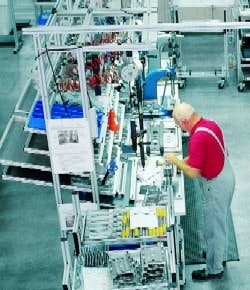Click here to view larger photo.Bosch Rexroth has introduced a line of manual production components designed to speed and simplify implementation of lean manufacturing systems to help companies reduce waste and increase productivity. The new Manual Production Systems (MPS) product line delivers a broad array of configurable products to create production systems for all industry segments. MPS is based on Rexroth’s extensive line of modular aluminum framing components, combined with its proven, ergonomically-tested manual workplace components. MPS adds a range of new workstations and accessories designed to make it easy to follow lean production principles such as one-piece flow, line-side parts stores, and water-spider inventory replenishment. Production demands can change rapidly and MPS gives customers the ability to adapt quickly as demand dictates. All systems are easily configurable and can be adjusted to any workplace requirements. Users can configure ergonomic workstations to fit dimensional and functional needs thanks to the flexibility and wide range of the structural framing components and workplace accessories from Rexroth. Many MPS components, such as complete workstations, tabletops, flow racks, material shelves and other accessories are ESD (Electro-Static Discharge) safe, which expands the application range of lean manufacturing systems.To speed design and implementation, users can quickly design workstations and material flow racks with MPScalc design software. MPScalc captures all critical parameters such as dimensions, material type and quantity, and allows users to design a workstation with just few clicks of a mouse, calculate its price, and produce accurate 3D drawings.Rexroth’s Manual Production Systems provide a complete, easy-to-use lean manufacturing solution, allowing manufacturing and plant engineers to implement any degree of lean production. The system ensures that no space is wasted and ergonomic principles are built-in for optimal working conditions. The result is reduced waste and maximum productivity, worker efficiency and quality.





